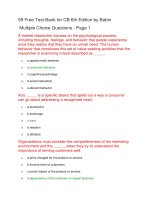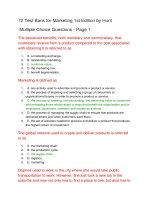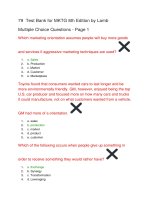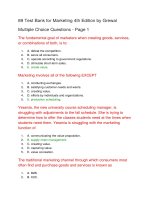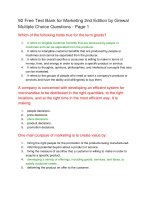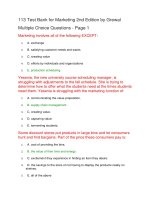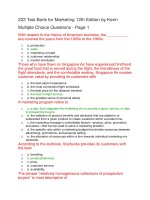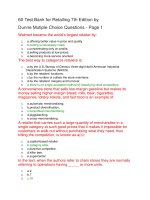Test bank for biochemistry 4th edition by mathews
Bạn đang xem bản rút gọn của tài liệu. Xem và tải ngay bản đầy đủ của tài liệu tại đây (505.11 KB, 16 trang )
Link full download: />
Test Bank for Biochemistry 4th Edition by Mathews
Biochemistry, 4th Edition Study Aid Test Bank – Mathews
Sample
Chapter 7
Multiple Choice Questions
1) Myoglobin without a heme group would be considered a(n) _______.
1.
2.
3.
4.
5.
A) apoprotein
B) holoprotein
C) apoenzyme
D) holoenzyme
E) none of the above
Answer: A
Difficulty: 1
Proteins
Topic: The Mechanism of Oxygen Binding by Heme
2) When oxygen is bound to myoglobin, the amino acid _____ is complexed to the iron
ion of the heme group while _______ forms a hydrogen bound to the oxygen.
1.
2.
3.
4.
5.
A) cysteine; serine
B) cysteine; histidine
C) serine; cysteine
D) histidine; histidine
E) histidine; cysteine
Answer: D
Difficulty: 1
Proteins
Topic: The Mechanism of Oxygen Binding by Heme
3) Which of the following explains why the ferrous ion is not oxidized to the ferric
state in the globin proteins even though free heme in solution is readily oxidized?
1. A) when bound to globins, the heme is always planar; when free in solution,
heme adopts a non-planar configuration which allows the oxidation of the
iron
2. B) the globin proteins provide a hydrophobic environment that prevents
oxidation
3. C) coordination with the proximal histidine allows any oxidized iron to be
rapidly reduced back to the ferrous state
4. D) since the oxygen is hydrogen bound to the distal histidine, if oxidation of
iron does occur, the distal histidine allows for rapid reduction
5. E) none of the above
Answer: B
Difficulty: 2
Proteins
Topic: The Mechanism of Oxygen Binding by Heme
4) Recent studies have shown that the H-bond between the distal histidine and
oxygen molecule in myoglobin has a strength of ~ 15 kJ/mol, but in hemoglobin, the
strength of the bond is only ~8 kJ/mol. What does this suggest about the
differences between myoglobin and hemoglobin?
1.
2.
3.
4.
5.
A) myoglobin binds oxygen more strongly than hemoglobin
B) hemoglobin binds oxygen more strongly than myoglobin
C) the iron in myoglobin is more easily oxidized than in hemoglobin
D) the iron in hemoglobin is more easily oxidized than in myoglobin
E) none of the above
Answer: A
Difficulty: 2
Proteins
Topic: The Mechanism of Oxygen Binding by Heme
5) Based on the plot of oxygen saturation versus partial pressure of oxygen, which
of the following statements is true?
1. A) at oxygen pressure >100 mm Hg, hemoglobin dissociates into individual
subunits so that it is able to bind oxygen similar to myoglobin
2. B) at typical resting capillary oxygen pressure of ~30 mm Hg, hemoglobin has
only 1 of its 4 oxygen binding sites filled while myoglobin is nearly saturated
with oxygen
3. C) under periods of extreme muscle exertion, capillary oxygen pressure can
drop to 10 mm Hg, allowing release of ~90% of oxygen carried by
hemoglobin
4. D) the structure of hemoglobin allows for complete release of oxygen in
capillary beds at all times
5. E) none of the above
Answer: C
Difficulty: 2
Topic: Oxygen Transport
6) The binding of oxygen to hemoglobin is said to be _______________.
1.
2.
3.
4.
5.
A) high affinity
B) low affinity
C) sigmoidal
D) cooperative
E) sequential
Answer: D
Difficulty: 1
Topic: Oxygen Transport
7) Changes in hemoglobin’s oxygen affinity are primarily the result of changes in the
_________ structure of the protein.
1.
2.
3.
4.
5.
A) primary
B) secondary
C) tertiary
D) quaternary
E) all of the above
Answer: D
Difficulty: 1
Topic: Oxygen Transport
8) A typical Hill plot (log [YO2/(1- YO2)] vs log PO2)for hemoglobin-oxygen binding
does not yield a straight line as it does for myoglobin. Which of the following is the
best explanation for this?
1. A) at high oxygen pressures, hemoglobin is in a low oxygen affinity state
2. B) at low oxygen pressures, hemoglobin is in a high oxygen affinity state
3. C) hemoglobin undergoes a transition from low affinity state under low
oxygen pressure to a high affinity state under high oxygen pressure
4. D) hemoglobin undergoes a transition from high affinity state under low
oxygen pressure to a low affinity state under high oxygen pressure
5. E) none of the above
Answer: C
Difficulty: 2
Topic: Oxygen Transport
9) Which of the following models of allosteric transitions best applies to
hemoglobin?
1. A) sequential (KNF) model
2. B) concerted (MWC) model
3. C) tertiary two-state model
4. D) tense versus relaxed model
5. E) none of the above
Answer: C
Difficulty: 1
Topic: Oxygen Transport
10) Which of the following interactions causes a change from the R state (oxy form)
to the T state (deoxy form) of hemoglobin?
1. A) interactions between heme groups
2. B) protonation of the R-group of His146 on the b subunit to allow formation
of a salt bridge with Lys40 on the a subunit
3. C) salt bridge formed by a1-Arg141 to the carboxylate of a2Asp126
4. D) protonation of the a1 subunit terminal carboxyl group disrupts a salt
bridge with a2Lys 127
5. E) none of the above
Answer: C
Difficulty: 3
Topic: Oxygen Transport
11) Which of the following occurs when hemoglobin switches from the T (deoxy)
state to the R (oxy) state?
1. A) the heme group goes from a slightly puckered conformation to a flat
conformation
2. B) the ferrous ion is pulled into the plane of the heme group
3. C) the F8 (proximal) histidine rotates about 8° to better align with the ferrous
ion
4. D) movement of the F8 histidine causes a shift in the F helix, thus weakening
interactions with other subunits
5. E) all of the above
Answer: E
Difficulty: 2
Topic: Oxygen Transport
12) Which of the following is a homotropic effector of hemoglobin-oxygen binding?
1.
2.
3.
4.
5.
A) O2
B) H+
C) CO2
D) Cl–
E) 2,3-bisphosphoglycerate (2,3-BPG)
Answer: A
Difficulty: 1
Topic: Allosteric Effectors of Hemoglobin
13) Which of the following reversible reactions of carbon dioxide explains how
hemoglobin serves as a transporter of carbon dioxide?
1. A) reaction with the imidazole group of the distal histidine where oxygen
would normally be bound
2. B) reaction with the carboxyl group of glutamic acid to form a carbonic acid
anhydride
3. C) reaction with the N-terminal amino groups to form a carbamate
4. D) reaction with the hydroxyl group of serine to form a carbonate
5. E) none of the above
Answer: C
Difficulty: 2
Topic: Allosteric Effectors of Hemoglobin
14) Which of the following is true regarding the effectors of hemoglobin-oxygen
binding?
1. A) an increase in blood pH will cause hemoglobin to bind more tightly to
oxygen
2. B) increased CO2 from increased muscle activity will result in an increase in
the R state of hemoglobin
3. C) increased Cl– will cause the formation of a salt bridge between two Lys
residues, one on an a subunit, the other on a b subunit
4. D) the binding site of 2,3-BPG contains several Asp and Glu residues which
are repelled by the similar charge, pushing the two b subunits away from
each other
5. E) all of the above
Answer: A
Difficulty: 2
Topic: Allosteric Effectors of Hemoglobin
15) The ability of some bacteria to resist the cytotoxic effects of macrophages is
most likely due to which of the following?
1. A) they have high levels of flavohemoglobin that allows for the destruction of
nitric oxide, a potent cytotoxic compound produced by macrophages
2. B) they possess a protein called cytoglobin that causes macrophages to
undergo apoptosis
3. C) they have high levels of a myoglobin-like protein that tightly binds oxygen,
preventing proper activity of the macrophage
4. D) they possess the protein neuroglobin which enables them to specifically
target nerve cells and thus evade macrophages
5. E) none of the above
Answer: A
Difficulty: 2
Topic: Other Functions of the Heme Globins
16) Which of the following mutations is correctly defined?
1. A) silent: change of a single base in the non-coding intron region of a gene
2. B) missense: substitution of a single base results in a premature stop codon
3. C) nonsense: substitution of a single base results in a complete change of
amino acid sequence
4. D) frameshift: deletion of a single base results in a single amino acid change
5. E) permissive: results in a protein that has greater thermodynamic stability
Answer: E
Difficulty: 2
Topic: Protein Evolution
17) Which of the following mutations in the coding strand of DNA would be the most
likely to cause a serious mutation?
1.
2.
3.
4.
5.
A) AGA ® CGA
B) ATA ® TTA
C) GAA ® AAA
D) TAA ® TGA
E) ACT ® AGT
Answer: C
Difficulty: 2
Topic: Protein Evolution
18) In sickle cell hemoglobin, a Glu is mutated to a _______. This causes the formation
of _______ between hemoglobin molecules, ultimately forming large aggregates.
1.
2.
3.
4.
5.
A) Arg; salt bridges
B) Cys; disulfide bonds
C) Val; hydrophobic interactions
D) Pro; disrupted a-helix, resulting in several H-bonds and salt bridges
E) none of the above
Answer: C
Difficulty: 2
Topic: Hemoglobin Variants
19) Why do individuals who are heterozygous for sickle cell anemia have a
resistance to malaria?
1. A) formation of hemoglobin aggregates makes red blood cells impervious to
parasitic infection
2. B) shortened life span of red blood cells does not allow sufficient time for the
parasite to mature in the red blood cell
3. C) diminished blood flow to the skin as a result of sickled red blood cells
blocking capillaries prevents mosquitoes from actually transferring the
malaria parasite to individuals
4. D) sickle cell hemoglobin fibers have both decreased O2 and CO2carrying
capacity; since CO2 is a mosquito attractant, diminished CO2exhalation does
not attract mosquitoes
5. E) none of the above
Answer: B
Difficulty: 2
Topic: Hemoglobin Variants
20) One would expect that defects in the globin genes would be so serious as to
cause death in utero. Which of the following explains how some thalassemias are
found in living people?
1. A) in b-thalassemia, the use of the g subunit allows individuals to live a
normal lifespan
2. B) individuals who completely lack functional a subunits can live if placed in a
hypobaric chamber to induce hypoxia
3. C) since humans have 4 copies of the a chain gene, effects are only seen when
at least 3 of the genes are nonfunctional
4. D) individuals with nonfunctional a chain genes can make b2g2tetramers that
function normally
5. E) none of the above
Answer: C
Difficulty: 2
Topic: Hemoglobin Variants
21) Which immunoglobulin is the only one to occur in a dimeric form?
1.
2.
3.
4.
5.
A) IgA
B) IgD
C) IgE
D) IgG
E) IgM
Answer: A
Difficulty: 1
Topic: Immunoglobulins
22) Which of the following methods could be used to produce a Fab fragment from
an IgG?
1. A) treatment with reducing agent, isolation of the light chain, removal of
reducing agent
2. B) treatment with reducing agent, isolation of the heavy chain, removal of
reducing agent
3. C) treatment with papain, separation of the Fab fragment from the rest of the
heavy chain
4. D) treatment with papain, separation of the Fab fragment from the rest of the
light chain
5. E) none of the above
Answer: C
Difficulty: 2
Topic: Immunoglobulins
23) Which of the following is responsible for the immense diversity of antibodies?
1.
2.
3.
4.
5.
A) recombination of introns
B) recombination of exons
C) variable domain recombination
D) epitope recombination
E) none of the above
Answer: B
Difficulty: 2
Topic: Immunoglobulins
24) Which of the following is the first step in the clonal selection theory for antibody
production?
1. A) binding of an antigen to an antibody on a B lymphocyte stimulates the cell
to replicate
2. B) B stem cells in the bone marrow differentiate to become B lymphocytes
3. C) immunoglobulins are exposed on the outer surfaces of the B lymphocytes
4. D) effector B cells and memory cells are produced
5. E) helper T cells recognize a bound antigen, bind to B lymphocytes and
stimulate B cell reproduction
Answer: B
Difficulty: 2
Topic: Immunoglobulins
Short Answer Questions
1) Given the following plot of oxygen binding versus pressure of O2 for myoglobin
and hemoglobin, (1) draw a curve that shows what happens when the pH is
increased to about 7.6 and (2) draw a curve that shows what happens when the pH
is decreased to about 6.8.
Answer:
Difficulty: 2
Topic: Allosteric Effectors of Hemoglobin
2) 2,3-Bisphosphoglycerate is known to interact with hemoglobin in the following
ways:
carboxylate with Lys
C-2 phosphate with protonated His
C-3 phosphate with N-terminal amino acid
Using the structure of 2,3-bisphosphoglycerate, show these interactions and identify
what type of interaction occurs.
Answer: All interactions are charge-charge interactions
Difficulty: 2
Topic: Allosteric Effectors of Hemoglobin
3) Using the following sequence from the coding strand of DNA, determine the
amino acid sequence of the corresponding protein. Make three different
mutations: (1) silent, (2) missense with little or no effect upon the protein structure
(indicate the amino acid substitution) and (3) nonsense.
